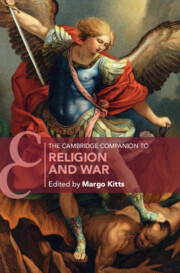Book contents
- The Cambridge Companion to Religion and War
- Cambridge Companions to Religion
- The Cambridge Companion to Religion and War
- Copyright page
- Contents
- Contributors
- Preface
- Introduction
- Part I Classical Foundations
- Part II Just War
- Part III Religious Nationalism
- Part IV Featured Conflicts
- 19 Christian Crusading, Ritual, and Liturgy
- 20 A Paradigm of Pious Jihād in the Muslim Ethos
- 21 Fierce Goddesses of India
- 22 The Demonological Framework of the Heavenly Kingdom of Great Peace
- 23 War Outside the State
- Index
- Cambridge Companions to Religion (continued from page ii)
- References
22 - The Demonological Framework of the Heavenly Kingdom of Great Peace
from Part IV - Featured Conflicts
Published online by Cambridge University Press: 04 May 2023
- The Cambridge Companion to Religion and War
- Cambridge Companions to Religion
- The Cambridge Companion to Religion and War
- Copyright page
- Contents
- Contributors
- Preface
- Introduction
- Part I Classical Foundations
- Part II Just War
- Part III Religious Nationalism
- Part IV Featured Conflicts
- 19 Christian Crusading, Ritual, and Liturgy
- 20 A Paradigm of Pious Jihād in the Muslim Ethos
- 21 Fierce Goddesses of India
- 22 The Demonological Framework of the Heavenly Kingdom of Great Peace
- 23 War Outside the State
- Index
- Cambridge Companions to Religion (continued from page ii)
- References
Summary
The so-called Great Peace or Taiping Rebellion is one of the most destructive events of Chinese history. Indigenous beliefs in the efficacy of violence to fight demonic beings, including humans identified as such, were an essential element of this event, next to Christian and Confucian sources of inspiration.
Keywords
- Type
- Chapter
- Information
- The Cambridge Companion to Religion and War , pp. 428 - 442Publisher: Cambridge University PressPrint publication year: 2023

